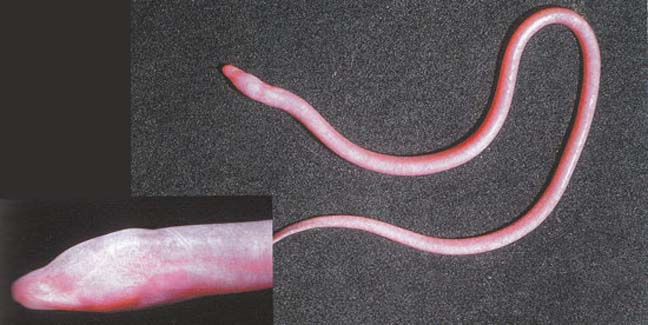Blind Cave Eel, Ophisternon candidum (Mees 1962)

Blind Cave Eel, Ophisternon candidum. Source: Gerald R. Allen. License: All rights reserved
A remarkable blind eel-like fish adapted to life in the total darkness of underground aquifers on the Cape Range Peninsula, northwest Western Australia.
Identifying features: body pinkish to whitish. eel-like, very long and slender, eyes and fins absent.
Blind Cave Eel, Ophisternon candidum (Mees 1962)
More Info
|
Distribution |
Endemic to an underground aquifer system beneath the coastal limestone on the Cape Range Peninsula, northwest Western Australia. These waters are brackish and are under tidal influence. The Blind Cave Eel is thought to burrow into soft sediments in wells and sinkholes within this system. The waters are often brackish as they are under tidal influence. Moore et al. (2018) showed that there are three genetically distinct populations separated by hundreds of kilometres in north Western Australia: Cape Range peninsula, Barrow Island, and Bungaroo. There is no connectivity between the populations. |
|
Features |
Vertebrae 150. Body eel-like, extremely elongate, rounded in cross-section; anus in anterior half of the body; no externally visible eyes; scales absent; fins absent except for a thin rayless membrane around tail tip. Lateral line distinct, continuing to near tail tip. |
|
Size |
To 40 cm TL |
|
Colour |
Unpigmented, white to pinkish overall. |
|
Feeding |
Feeds mostly on subterranean crustaceans, and also on terrestrial insects that fall into the wells and sinkholes. |
|
Biology |
The species has degenerate eyes, and sensory adaptations to life in total darkness. |
|
Conservation |
|
|
Remarks |
The Blind Cave Eel is one of only two Australasian vertebrates restricted to underground water - the other is the Blind Gudgeon Milyeringa veritas. Due to the inaccessibility of the habitat little is known of the Blind Cave Eel. |
|
Similar Species |
Easily distinguished from others in the genus in lacking eyes and skin pigment. |
|
Etymology |
The specific name is from the Latin candidus (= white) in reference to the skin colour. |
|
Species Citation |
Anomatophasma candidum Mees 1962, J. R. Soc. West. Aust. 45(1): 27, figs 1–2. Type locality: Tantabiddi Well, Yardie Creek Station, Northwest Cape, Western Australia. |
|
Author |
Bray, D.J. & Thompson, V.J. 2021 |
|
Resources |
Blind Cave Eel, Ophisternon candidum (Mees 1962)
References
Allen, G.R. 1982. Inland Fishes of Western Australia. Perth : Western Australian Museum 86 pp. 6 figs 20 pls.
Allen, G.R. 1989. Freshwater Fishes of Australia. Neptune, New Jersey : T.F.H. Publications 240 pp., 63 pls.
Allen, G.R., Midgley, S.H. & Allen, M. 2002. Field Guide to the Freshwater Fishes of Australia. Perth : Western Australian Museum 394 pp.
Cawthorn, P. 1963. Discovery of subterranean freshwater fauna on the eastern side of North West Cape. The Western Australian Naturalist 8(6): 129-132.
Humphreys, W.F 1999. The distribution of Australian cave fishes. Records of the Western Australian Museum 19: 469-472
Humphreys, W.F. & Adams, M. 1991. The subterranean aquatic fauna of the North West Cape peninsula, Western Australia. Records of the Western Australian Museum. 15(2): 383-411.
Humphreys, W.F. & Feinberg, M.N. 1995. Food of the blind cave fishes of northwestern Australia. Records of the Western Australian Museum 17: 29-33
Mees, G.F. 1962. The subterranean freshwater fauna of Yardie Creek Station, North-West Cape, Western Australia. Journal of the Royal Society of Western Australia 45(1): 24-32 figs 1-2
Merrick, J.R. & Schmida, G.E. 1984. Australian Freshwater Fishes Biology and Management. Sydney : J.R. Merrick 409 pp. figs 280 col. figs.
Moore, G.I. 2019. New morphological data and live photographs of the rare subterranean Blind Cave Eel Ophisternon candidum (Synbranchidae) from north-western Australia. Ichthyological Research 66: 160-165. https://doi.org/10.1007/s10228-018-0647-2
Moore, G. 2019. Ophisternon candidum. The IUCN Red List of Threatened Species 2019: e.T15386A123378485. https://dx.doi.org/10.2305/IUCN.UK.2019-3.RLTS.T15386A123378485.en. Downloaded on 17 June 2021.
Moore, G.I., Humphreys, W.F. & Foster, R. 2018. New populations of the rare subterranean Blind Cave Eel Ophisternon candidum (Synbranchidae) reveal recent historical connections throughout north-western Australia. Marine and Freshwater Research 69: 1517–1524. https://doi.org/10.1071/MF18006
Morgan, D.L., Allen, M.G., Beatty, S.J., Ebner, B.C. & Keleher, J.J. 2014. A field guide to the freshwater fishes of Western Australia's Pilbara Province. Murdoch University, Murdoch W.A.: i-iv + 1-65 + 4 unnumbered pp.
Proudlove, G.S. 2006. Subterranean fishes of the World. An account of the subterranean (hypogean) fishes described up to 2003 with a bibliography 1541-2004. International Society for Subterrnaean Biology, Moulis.
Romero, A. & Paulson, K.M. 2001. It's a wonderful hypogean life: a guide to the troglomorphic fishes of the world. Environmental Biology of 62: 13–41.
Rosen, D.E. & Greenwood, P.H. 1976. A fourth neotropical species of synbranchid eel and the phylogeny and systematics of synbranchiform fishes. Bulletin of the American Museum of Natural History 157(1): 1-69.
Unmack, P.J. 2001. Biogeography of Australian freshwater fishes. Journal of Biogeography 28: 1053-1089.
White, N.E., Guzik, M.T., Austin, A.D. et al. 2020. Detection of the rare Australian endemic blind cave eel (Ophisternon candidum) with environmental DNA: implications for threatened species management in subterranean environments. Hydrobiologia 847: 3201–3211. https://doi.org/10.1007/s10750-020-04304-z
Whitley, G.P. 1965. Illustrations and records of fishes. The Australian Zoologist 13(2): 103-120 figs 1-13



